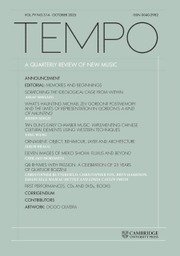Works of art are messages from a ‘foreign country’ in which, as L. P. Hartley tells us at the beginning of The Go-Between,Footnote 1 ‘they do things differently.’ Their subject matter – love, loss, adventure, anxiety – may be timeless, but time is written into the way it is expressed, each work a time-capsule packed with information about how things used to be communicated.
In 1995 Neil Heyde was working closely with Justin Connolly on the development of Connolly’s solo cello work, Collana. At a late stage in Heyde’s preparations for the premiere Connolly wrote him a long letter, going through the piece section by section, reflecting on his compositional decisions and offering suggestions as to how Heyde might meet the music’s challenges. The letter is, as Heyde suggests in the title of his article, a ‘time-capsule’: Connolly died in 2020 but the letter preserves his ideas about Collana and Heyde explains how they have informed his recent recording of the work. Heyde also considers how his response to Connolly’s letter might relate to the burgeoning research area of composer-performer collaboration, or CPC as it is usually known. Politely, Heyde suggests that CPC has a problem ‘in balancing the essential requirement of documentation with the need to establish thresholds for significance’; less politely, I would suggest that many CPC projects replace the forensic critique of Connolly’s thoughts on Collana with acquiescent autoethnography.
Ed Cooper’s article on ‘post-critique and “The New Discipline”’ addresses another example of critical acquiescence, the current tendency to avoid a critical interrogation of texts, in whatever medium, and instead to respond to new work in a mode that is both ‘complementary and complimentary.’ It will be interesting to see what sort of response is triggered by Cooper’s article. I suspect that some readers may mistake his detailed scrutiny of Jennifer Walshe’s original ‘New Discipline’ text, carefully disentangling its significance from its reception, as hostility; to be properly understood the article needs to be read attentively and, as Cooper proposes, ‘against the grain.’
One of the composers listed in the original ‘New Discipline’ document was Matthew Shlomowitz and in this issue he follows his TEMPO 311 provocation, ‘It’s not about you: do we need a “compositional voice”?,’ with an article in which he argues for a revival of neo-classicism. This may seem to be very much against the grain of new music today and Shlomowitz’s advocacy of ‘entertainment’ as a neglected aspect of contemporary classical music could well raise a few eyebrows, but perhaps neo-classicism’s capacity for wit, humour and formal clarity might also attract a few more listeners. Shlomowitz offers some structural models that might characterise a neo-classical revival, one of which includes an ‘unexpected and unrelated insert’ whose extended presence disrupts the orderly form that frames it, and Ty Bouque’s article, ‘Outside inside (love)’ examines why these musical parentheses are so disconcerting. For Bouque these moments are more than an engaging formal device, ‘exterior to some other, more substantive sound’; instead, he claims, they are at the heart of the music in which they occur, its ‘own interiority’, the place ‘where it sees itself alone.’
Two more articles take us back to the time-capsule metaphor. Perhaps nothing date-stamps new music more precisely than its use of technology, from new keys on woodwind instruments to harp pedals and valve amplifiers, but each wave of instrumental innovation also inspires fresh ideas about how music can be made. Solomiya Moroz and Craig Vear’s article is a report from the ERC-funded ‘Digiscore’ project at Nottingham University and considers how digital scores can transform musical practice. Their work explores the new sorts of engagement with music-making that technology can enable and, from a wide range of case studies, those that emphasise accessibility seem particularly worthwhile. Perhaps it will be this sort of work, in which technology is instrumental in improving people’s lives, that defines the creative preoccupations of our time? Or perhaps it will be work that documents the current obsession with out-sourcing our humanity, like Hao Weiya’s chamber opera AI Variation? In ‘Listening for human agency’ Dong Yikun introduces the opera and, as her title goes on to suggest, its ‘sounding’ of the ‘human/machine interface’ in a future where an artist is reanimated as an artificial intelligence to carry on his work. Premiered in Shanghai in 2021, the opera launches at least two time-capsules into the future: Dong Yikun’s analysis demonstrates how Hao Weiya’s music draws on harmonies, textures and quotations that reach back to the end of the nineteenth century; it is the opera’s ideas about AI, however, that, only four years from its creation, will probably date it most precisely.
* * *
This issue of TEMPO brings us close to the end of the era in which the journal has been published by Cambridge University Press. After TEMPO 314 appears in October we will move to a new home and, with the January 2026 issue, begin the next phase of the journal’s long life. As I write there are still details of the transfer to be resolved, so the identity of the new publishers cannot yet be revealed, but readers should expect news soon about how to move their subscriptions. We hope you will come with us!


